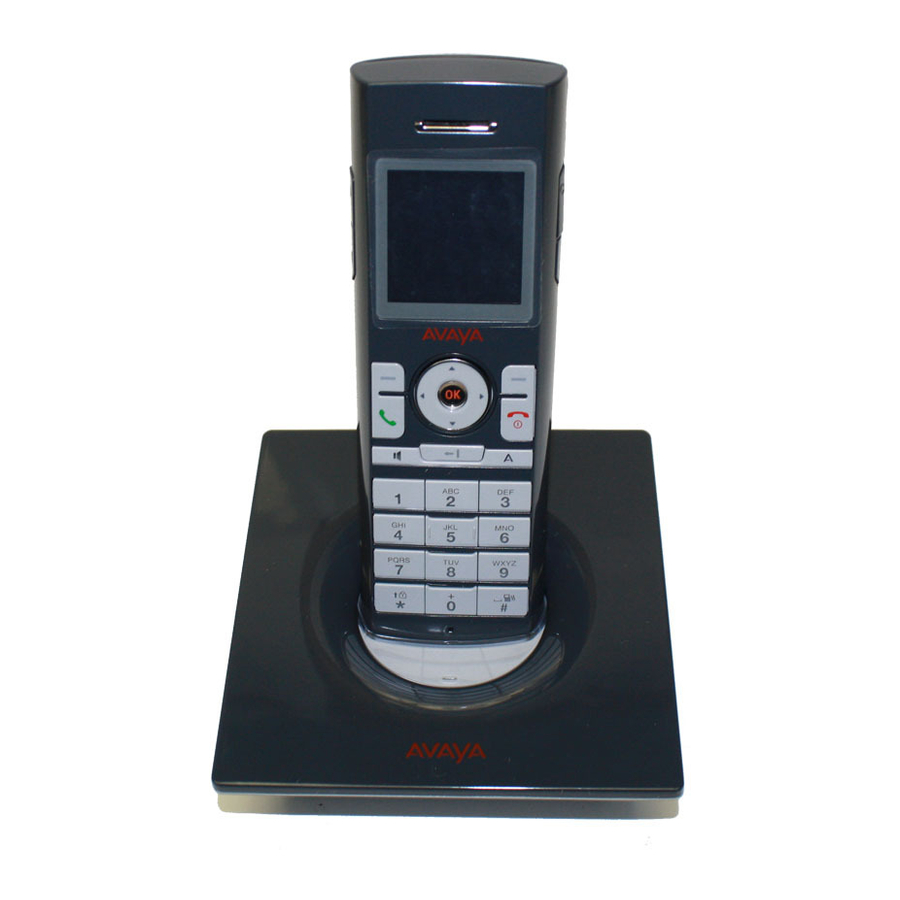Avaya 3641 Installatiehandleiding - Pagina 7
Blader online of download pdf Installatiehandleiding voor {categorie_naam} Avaya 3641. Avaya 3641 19 pagina's. Co-existence with ip wireless handset offering
Ook voor Avaya 3641: Snelle referentiehandleiding (2 pagina's), Gebruikershandleiding (2 pagina's), Configuratiehandleiding (8 pagina's)

Installation Guide
delay to the overall network, which are generally not tolerable for real-time voice connections. Avaya
does not support a configuration that includes wireless bridges and does not recommend using
wireless bridges with any wireless network supporting voice.
Power
2.3.2 Transmission Power
The transmission power of APs can be increased or decreased, to provide more or less AP radio
coverage. For Avaya handsets, the transmission power setting must be the same for all APs in a
facility. This will minimize the opportunity for higher-power devices to interfere with nearby lower-
power devices, while providing consistent coverage.
Avaya wireless telephones support statically configured transmission power settings in the range from
5mW to 100mW. Lower power settings on the APs and handsets can be used to provide added overall
capacity by increasing the density of access points in the network. In such deployments, special
attention must be given to AP placement, to ensure there are no frequency reuse issues. Regardless
of the selected power level settings, all APs and handsets must be configured with the same settings
to avoid channel conflicts and unwanted cross-channel interference. For access points that support
automatic transmission power adjustments, Avaya recommends using only static power settings to
ensure optimal performance of the Avaya wireless telephones.
The AP transmit (TX) power should be set so that the handsets receive the required minimum signal
strength, as defined in Section 2.1.2 of this document. For deployments with higher AP density, lower
TX power settings are typically required to prevent channel interference. Maximum AP power settings
vary by band and by channel, and can vary between countries. Local regulations should always be
checked for regulatory compliance considerations. In addition, maximum power output levels may
vary by AP manufacturer.
In mixed 802.11b/g environments, Avaya recommends configuring the TX power of the 802.11b and
802.11g radios to the same setting, if they are separately configurable. For example, set both radio to
30mW to ensure identical coverage on both radios. For mixed 802.11a/b/g environments, where the
AP utilizes all three radios types, AP placement should first be determined by modeling for the
characteristics of 802.11a, since this environment will typically have the shortest range. Then, the TX
power of the 802.11b and 802.11g radios should be adjusted to provide the required coverage levels
for those networks, within the already established AP locations.
Where possible, all APs should be set to the same TX power level within a given radio type. For
example, set all 802.11a radios to 50 mW and set all 802.11b and 802.11g radios to 30 mW. It crucial
to then set the TX power of the handset to match the TX power of the APs. This will ensure a
symmetrical communication link. Mismatched TX power outputs will result in reduced range, poor
handoff, one-way audio and other quality of service issues.
2.3.3 Interference
Interference on a wireless network may originate from many sources. Microwave ovens, Bluetooth
devices, cordless phones and rogue APs are among the many potential sources. In general, devices
that employ or emit radio frequency signals within a given radio coverage area will have the potential
to cause unwanted interference.
Radio frequency spectrum analyzers can be used to help identify the sources of such interference.
Once identified, interference is best mitigated by removing the interfering device(s) from the network
area. Otherwise, it may be possible to change the channel setting of the interfering device to avoid
conflict with the surrounding APs. If this is also not possible, then the channel of the surrounding APs
may be able to be changed to avoid as much frequency overlap with the interfering device.
Octiober 2008
7
